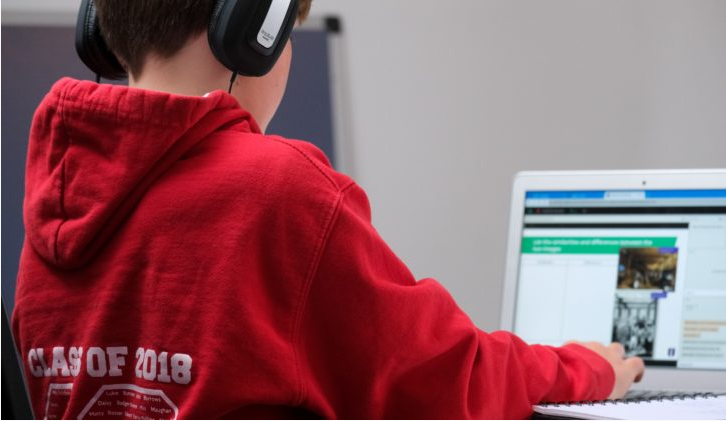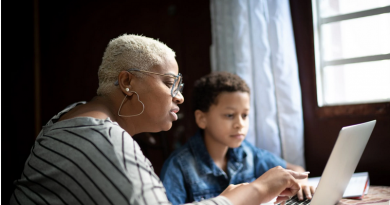Staying the course: Lessons learned from digital learning
During the COVID-19 pandemic, students spent several hours a day learning in front of a computer screen. Many saw this as a detriment to our education system. And while, yes, many supports that our public schools offer our students and families weren’t met, some surprising opportunities arose for students to learn in a new environment and for teachers to push their instructional strategies to meet the needs of our 21st-century learners. Now that we’ve returned to a more normal state, what does our experience with remote instruction say about the future of digital learning?

While many of our students can be defined as digital natives, as an educational system, we weren’t fully prepared to make the necessary instructional shifts — at least not in a transformational way.
When classes moved online, many teachers naturally continued with practices they were most comfortable with and had been using for years. As a result, the common instructional model in which teachers deliver knowledge to students shifted online. However, while we saw little change in some classrooms, we also saw some amazing shifts in instruction in others.
Lessons should actively engage students.
A teacher-centric approach is not what students need in the classroom, regardless of the medium. Engagement easily drops when this type of instruction occurs virtually, and the necessary digital tools are not utilized. Students, just like most learners, lose interest in just a sit-and-get lesson. Instead, students need to be actively involved in the learning process.
In Denver Public Schools’ classes, where teachers were familiar with digital strategies for creating more dynamic, student-centered learning environments, students fared better in the shift to remote instruction — and some even excelled further. As a result, we’ve found that students are deeply engaged in their education, regardless of where digital learning occurs.
These best practices give educators a road map for using digital tools in a highly strategic way to make learning more active and engaging. Our experience shows three keys to using digital tools and techniques to enhance teaching and learning.
Digital learning can flip the script.
One of the mindsets that we cultivate in our teachers is the notion of student empowerment by putting students in charge of their learning. Instead of conveying information to students, teachers guide students in doing their own research and sharing research with each other through a peer instructional model.
For instance, our students use their district-issued laptops to research topics or solve problems and use some of our supported platforms such as Seesaw, Schoology, Screencastify, Pear Deck and DisplayNote. Screen sharing is integrated within our classrooms through interactive whiteboards so students can share their findings with the rest of the class. Students explain what they learned or how they arrived at their solution, and they also get to hear other students explain their own findings or thought processes.
This type of learning is much more powerful than students simply taking in information from their teacher. When students present their own findings or conclusions to the class, they learn the content at a deeper level by having to explain it to others. And when students are learning from their peers, they’re picking up new problem-solving strategies they might not have thought of for themselves. Students are also much more engaged because they have agency over the learning process.
The result is a richer learning experience for everyone.
Give students a voice and choice.
Another way to give students agency over their learning is by letting them choose how they’ll demonstrate their understanding.
Suppose students are learning about the civil rights movement in the 1960s. They might create a slideshow presentation to show what they’ve learned in this unit. They might design a pamphlet advertising a march. Or, they might use a digital tool to record themselves explaining what they’ve learned.
Giving students options to demonstrate their learning puts them in the driver’s seat and allows them to select the most engaging method.
Extend learning beyond the classroom
Connecting their work to real-world problems and audiences is yet another way to invest students in their education. Students who complete projects only for their teacher often feel less empowered by their learning. However, when they’re working on a project that they know makes an impact and has a larger purpose than just a grade, we’ve found that their motivation soars.
Our teachers often have students apply their knowledge by challenging them to make a difference in the world. For example, when students studied water pollution, they wrote letters to government officials describing their findings. When elementary students studied endangered animals, they raised money for conservation initiatives. Our students frequently use digital tools to publish their knowledge and communicate with authentic audiences around the world.
Engagement for even the youngest students
I’ve heard people say there’s no way first-grade students can engage in this type of student-centered learning. My response is, “Yes, they absolutely can.” With the right preparation and scaffolds in place, it’s amazing what students can do. We just need to loosen the reins and focus on student empowerment.
For those skeptical of digital learning after the experience of the pandemic, it’s not the amount of screen time that’s the problem — it’s how that time is used. Aided by highly skilled teachers along with a supportive educational system, we’ve found that digital tools help create more active, student-centered learning environments that lead to better outcomes.
Source: https://corp.smartbrief.com/original/2022/11/lessons-from-digital-learning?utm_term=AEE6C64D-A551-4448-AC86-73E9EA97DDFE&utm_content=459DC1CD-0D25-46F7-AF2E-5D52E71BE7A2&utm_source=brief




